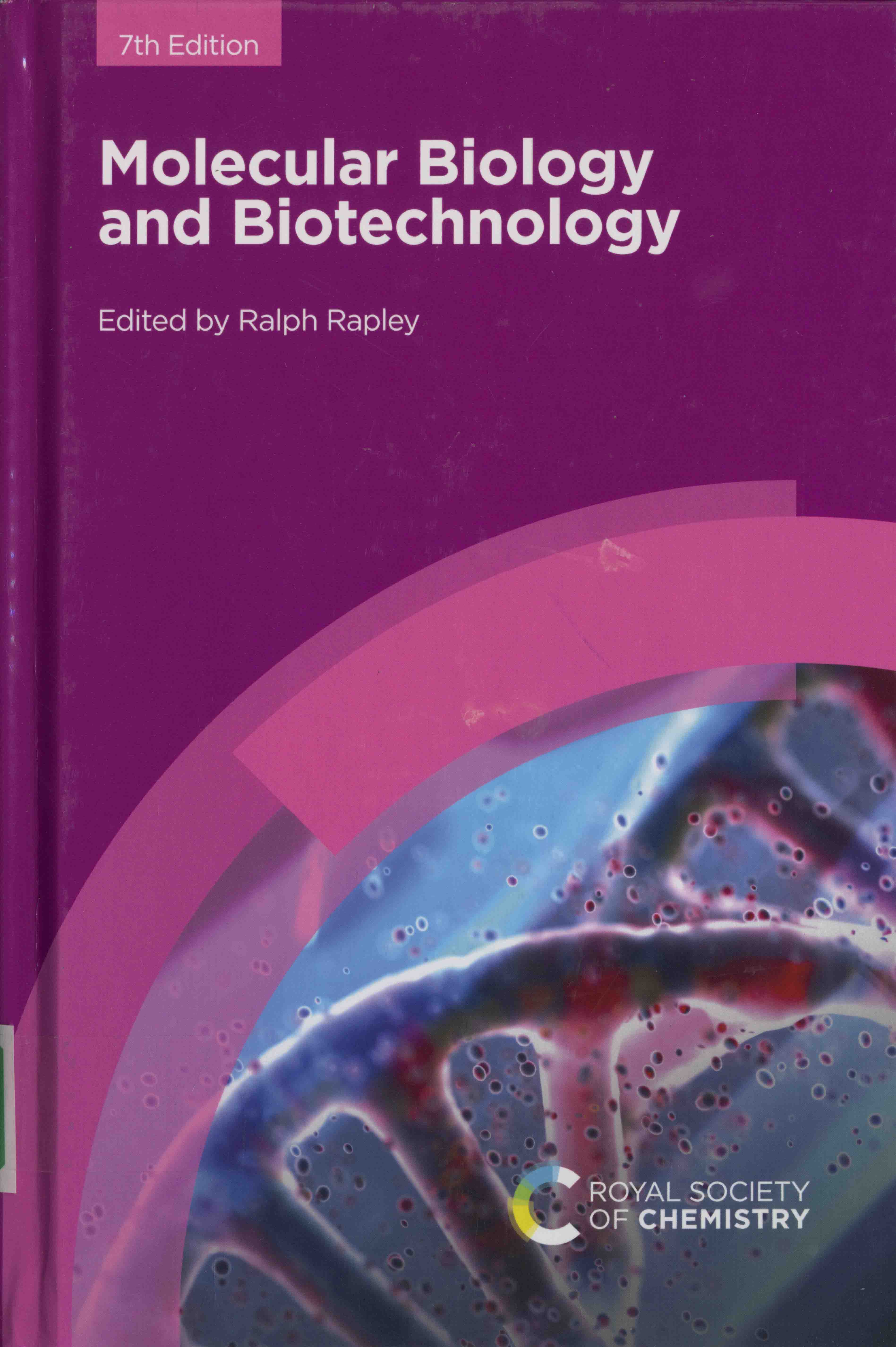 |
Molecular biology and biotechnology / edited by Ralph Rapley, University of Hertfordshire, UK. -- 7th edition. -- London : Royal Society of Chemistry, [2021]. – (58.17/M718c/7th ed.) |
Contents
1 Basic Molecular Biology Techniques
1.1 Introduction
1.2 Structure of Nucleic Acids
1.3 Isolation and Separation of Nucleic Acids
1.4 Basic Mapping and Analysis of DNA Fragments
1.5 Gene Probes and Artificial DNA Synthesis
1.6 The Polymerase Chain Reaction (PCR)
1.7 Quantitative or Real-time PCR (qPCR)
1.8 DNA Sequencing
1.9 Microarrays
1.10 Conclusion
References
2 Genes and Genomes
2.1 Introduction
2.2 Recombinant DNA Technologies
2.3 Genome Analysis
2.4 Genome Projects Background
2.5 Gene Discovery and Localization
2.6 Conclusion
References
3 Protein Expression and Production
3.1 Introduction
3.2 Host-related Issues
3.3 Vectors
3.4 Expression Problems
3.5 Fusion Proteins
3.6 Cell-free Systems
3.7 High-throughput Approaches
3.8 Other Hosts
3.9 Conclusion
References
4 Proteins and Proteomics
4.1 Introduction
4.2 Protein Chemistry
4.3 Proteomics Workflow: Sample Preparation
4.4 Electrophoretic Methods
4.5 2D Gel Electrophoresis
4.6 Protein Identification: Mass Spectrometry
4.7 Protein Identification: Bioinformatics
4.8 Expression Proteomics
4.9 Practical Applications
4.10 Conclusion
Bioinformatics Sources Cited in the Text
References
5 Transgenesis 1
5.1 Introduction
5.2 Transgenesis by DNA Pronuclear Injection
5.3 Gene Targeting by Homologous Recombination in Embryonic Stem Cells
5.4 Conditional Gene Targeting
5.5 Tetracycline-inducible Gene Switch System
5.6 Genome Editing by Engineered Endonucleases
5.7 Phenotypic Analysis of Genetically Modified Mice
5.8 Ethical and Animal Welfare Considerations
5.9 Conclusion
Acknowledgements
References
6 The Biotechnology and Molecular Biology of Yeast
6.1 Introduction
6.2 Production of Heterologous Proteins by Yeast
6.3 Sophisticated Recombinant Cloning Techniques for the Large-scale Manipulation of DNA
6.4 Development and Application of Post-genomic Analysis Techniques
6.5 Rational Design of Yeast Biology
6.6 Future Prospects
References
7 Antibody Engineering and Immunotherapeutics
7.1 Introduction
7.2 Antibody Structure and Function
7.3 Hybridoma Technology
7.4 Therapeutic Antibodies
7.5 Molecular Engineering of Antibodies
7.6 Surface Display Technology
7.7 Production of Antibody Fragments
7.8 Bispecific Antibodies
7.9 Molecular Redirection of Immune Cells
7.10 Single-cell Technology and Transgenics
7.11 Conclusion
References
8 Human and Animal Cell Culture
8.1 Introduction
8.2 Understanding and Standardising In Vitro Culture Systems
8.3 Quality Assurance
8.4 Documentation
8.5 Safety
8.6 Legal, Ethical and Regulatory Compliance
8.7 Education and Training
8.8 Conclusion
References
9 Genome Editing
9.1 Background
9.2 Targeted Mutagenesis Using ZFNs
9.3 Genome Editing with TALENs
9.4 The CRISPR/Cas System
9.5 Case Study: CRISPR/Cas9 Gene Editing in Crop Plants
9.6 Ethical and Regulatory Issues Related to Genome Editing
References
10 Genome Sequencing
10.1 Introduction
10.2 A Brief History of DNA Sequencing
10.3 Preparing for Next-generation Sequencing
10.4 Data Analysis
References
11 Introduction to Bioinformatics
11.1 Introduction
11.2 Primary and Secondary Databases
11.3 Bioinformatics Data Formats
11.4 NCBI BLAST and PubMed Resources
11.5 Protein Databases
11.6 Specialised Disease-related Databases
11.7 Secondary and Specialised Databases
11.8 Laboratory Bioinformatics
11.9 Concluding Remarks
References
12 Nanotechnology in Medicine
12.1 Introduction
12.2 Nanomaterials
12.3 Clinically Approved NPs
12.4 Future Prospects
References
13 Biosensors
13.1 Introduction
13.2 The Biological Reaction
13.3 Theory
13.4 Electrochemical Methods
13.5 Piezoelectric Biosensors
13.6 Optical Biosensors
13.7 Whole-cell Biosensors
13.8 Receptor-based Sensors
13.9 Conclusion
References
14 Modelling and Simulation of Proteins
14.1 Introduction
14.2 Prediction of Protein Structure
14.3 Molecular Dynamics Simulation
14.4 Conclusion
References
15 Agricultural Biotechnology
15.1 Introduction
15.2 Today's Agricultural Biotechnologies
15.3 Biotic Stresses
15.4 Tolerance to Abiotic Stresses
15.5 Improved Yield and Nutrition Using Genetic Modification
15.6 Potential to Improve Human Health via the Biofortification and Nutritional Enhancement of Food Crops
15.7 Phytoremediation Using Agricultural Biotechnology
15.8 Agricultural Biotechnology and Biofuel Development
15.9 Consumer Acceptance of Plant Biotechnology
15.10 Conclusion
References
16 Vaccine Design Strategies: Pathogens to Genomes
16.1 Introduction
16.2 Immunological Considerations in Vaccine Design
16.3 Vaccine Design Strategies
16.4 Reverse Vaccinology: Genome-based Vaccine Design
16.5 Recombinant Vector Vaccines
16.6 Nucleic Acid-based Vaccines
16.7 Synthetic Peptide Vaccines
16.8 Vaccine Adjuvants and Delivery Systems
16.9 Concluding Remarks
References
17 Intellectual Property and Biotechnology Patents
17.1 Background to Patents
17.2 CRISPR Patents
17.3 Patent Battles
17.4 CRISPR-related Patentscape
17.5 Patent Licensing
17.6 It's Not All Over Yet
References
Subject Index